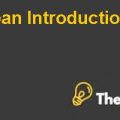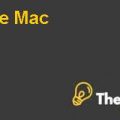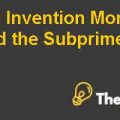
Question 1. What is the appropriate cow size of the herd using the 50% weaning rule?
Answer:
The appropriate cow size of the herd under the 50 percent weaning rule is 1100 lbs as it is the most appropriate percentage of the weaning. In addition to the weaning rule, the 1100 lbs is appropriate because of the reason that, no matter what the weight of the cow, but at 1100 lbs of weight; the loss will be lower. As a result of lower loss, the 1100 lbs will be the appropriate cow size.
Please refer the Exhibit 1 for determining the appropriate cow size.
Question 2. Compare the value of a calf to the cost of maintaining the cow as an alternative means of determining appropriate cow size. Hint: Calculate marginal revenue and marginal expense. Which method (50% weaning rule or marginal analysis) do you think provides the best measure? Why?
Answer:
The most appropriate method that is used to compare a calf value to the cost of maintaining the cow is the marginal analysis as it gives the marginal revenue that is calculated as changes in the revenue is divided by the changes in output in terms of quantity.
For the comparison of a calf value to the cost of maintaining the cow against determining the cow size, the measure that is used under each weight class of cow is the cost of selling the calves in comparison with the cost of maintaining the cows. To support the above answer, calculation has been made in Excel sheet in which the total cost is the cow’s maintenance cost and total revenue is revenue generated by the sales of calves.
Question 3. What are the drivers in a cow-calf operation? Is the revenue-expense calculation (see Exhibit 2) clear regarding drivers? Why or why not?
Answer:
The cattle show that was broadcasted on RFD TV discussed the size of the cow; the key driver is the weight of the cow that should be incorporated as a direct cost. The calculation of revenue and expense is done in Exhibit 2. It is not clear as the driver that was used in it was number of cows because RFD TV had given the driver that was the size of the cow and not the number of the cows.
Question 4. How would you change the detailed statement of revenues and costs so that it provides information that would help Green make her decision?
Answer:
The detailed income statement should be changed accordingly to the managerial accounting as it has fewer rules against the financial accounting. Managerial accounting also incorporates only this information and it is useful in making decisions as it can easily be prepared in terms of meaningful manners that help the Green in decision making.
Question 5. To what extent is the Greens’ confusion a result of the failure of the accounting system?
Answer:
The failure of the accounting system that was adopted by the Green’s accountant is not the failure of the accounting system as the key driver that was used was not properly determined and when that driver was determined then the accounting system automatically corrected all the reporting of the income statement through which the decision can easily be made.................
This is just a sample partial case solution. Please place the order on the website to order your own originally done case solution.
The owner of the cow-calf operation is necessary to determine the appropriate weight of the cows in the herd. National trends for decades has been to increase the weight of the cow, because they produce more calves, but the evidence that cow weight, may have reached the point where the cost of maintaining large cow was more than the profit from the production of a larger calf. In analyzing this issue introduces the ultimate principle of the economy. Case can be extended to the discussion of drivers and distribution costs, which are managerial accounting principles. "Hide
by David Curry, Lauren Mosnja Skare Source: Richard Ivey School of Business Foundation 7 pages. Publication Date: May 03, 2010. Prod. #: 910B04-PDF-ENG












